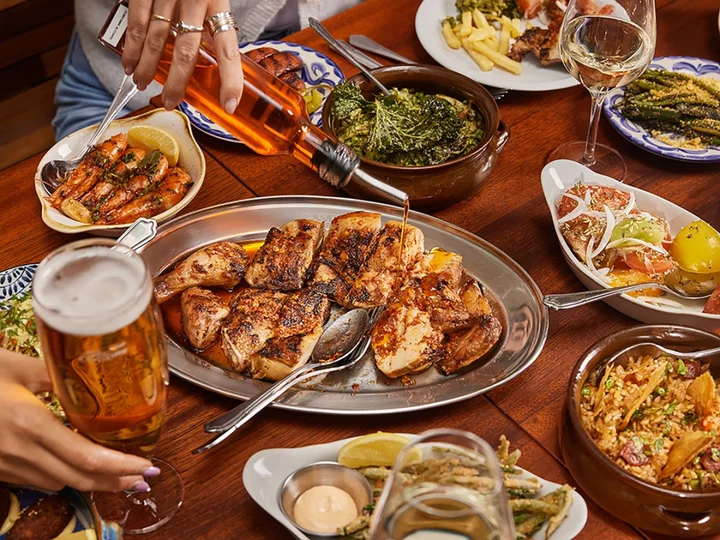
China’s Travel Rebound Risks Super-Charging Jet Fuel Prices
After years of pent-up demand for leisure and business travel due to the ravages of Covid-19, millions of
1970-01-01 08:00

Boil-water notice issued after E. coli found in water supply near Phantom Ranch at Grand Canyon National Park
A boil water advisory has been issued after E. coli bacteria were found in the water supply near Phantom Ranch at Grand Canyon National Park, officials warned Friday.
1970-01-01 08:00

This is why you should never order a cappuccino after lunch, according to Italians
Apparently most people are drinking their coffee completely wrong – and you’d better believe it, because it’s according to an Italian chef. Italian coffee lover Nadia, who has more than two million followers on her Instagram account The Pasta Queen, had a message for followers in her latest video. As an off-camera voice asked if she wants to have a cappuccino, she rolled her eyes and said: “No. It’s past 12.” Italians don’t drink cappuccinos after midday, she explained, adding: “It’s a breakfast drink.” “It's frothed milk! It’s good to awaken your senses before 10. If you really want to push it, 11. But not after 12.” She adds that when you’re eating a meal, “you’ve got enough going on” in your mouth and your stomach. “All you need is a quick espresso,” she said. “It’s like an American having a hot dog for breakfast.” However, some people seem not to appreciate being told when to drink their favourite coffee. Beneath the video some commenters were bewildered by the instruction. One person said: “I ordered a cappuccino in Italy, the waiter said no.” One viewer said: “I will continue to have my cappuccino morning, noon and night! I will especially continue to ask for a cappuccino after dinner when travelling in Italy just so I can p*** off the waiter.” Another said: “I am Italian and know of this ‘rule’ yet it did not phase me… I still ordered my cappuccinos in the afternoon and watched several natives enjoying one as well… It’s just steamed milk with espresso? Not sure what the big deal is? I say drink what you want, when you want. Respectfully.” However, others decided to trust the expert and sided with Nadia. A person commented: “You underestimate the power of Americans having just about ANYTHING for breakfast including last night’s leftovers.” It seems, as with most things food-related, the Italians know best. Sign up to our free Indy100 weekly newsletter Have your say in our news democracy. Click the upvote icon at the top of the page to help raise this article through the indy100 rankings.
1970-01-01 08:00

Snoring before age 50 is a health ‘red flag’, experts suggest
Young adults who snore at night have a significantly higher risk of having a stroke and developing heart disease when they get older, a study has warned. Doctors have said that snoring should be treated as a “red flag” among adults below the age of 50. The study found that young adults who snore are 60 per cent more likely to develop a stroke when they reach middle age, and five times more likely to develop a heart rhythm disorder. The researchers presented their findings at the European Society of Cardiology Congress in Amsterdam. They examined data from 766,000 US adults aged 20 to 50. These included 7,500 adults with obstructive sleep apnoea, a condition that causes interruptions to normal breathing during sleep. This can lead to loud snoring and interrupted sleep as sufferers wake up while struggling to breathe. The study found that, over the 10-year follow-up period, patients with sleep apnoea were 60 per cent more likely to suffer a stroke compared to those who did not snore as frequently. They were also five times more likely to develop atrial fibrillation, a heart condition that causes irregular and often abnormally fast heart rate. Symptoms of atrial fibrillation include heart palpitations, dizziness and shortness of breath. Lead author Professor Sanjiv Narayan, of Stanford University, said: “Sleep apnoea is really common but we sort of ignore it because we think it’s trivial or just a little bit of a nuisance. “Until now no one’s really shown the magnitude of the size of the risk for heart diseases. That’s what really surprised us.” He added that the study looked at “relatively young people” who may not know they are at risk. “If they had a stroke, it would devastate young families. It could take them away from their workplace. It would destroy their lives for the next 40 years.” The researchers suggest that GPs should ask patients regularly if they snore and highlight if as a heart health “red flag” that could show they need more tests or medication. Obstructive sleep apnoea is fairly common and is estimated to affect 1.5m adults in the UK. However, according to the British Lung Foundation, up to 85 per cent of sufferers are undiagnosed and go untreated. Men who are elderly and overweight are particularly prone to sleep apnoea. Interruptions to normal breathing can cause a dip in blood oxygen and cause the heart and blood vessels to strain. Prof Narayan explained: “When you are unable to breathe it raises the pressure in the lungs until you ultimately wake up gasping for breath. That puts a pressure load on the heart, which causes stretch in the heart chambers, and that could cause the atrial fibrillation. “Another theory could be that the oxygen levels in the blood fall for tens of seconds and that could put stress on the heart.” Sleep apnoea can be treated using a CPAP machine, a device that pumps air into a mask that the patient wears over their mouth or nose while they sleep. The NHS also recommends making lifestyle changes such as losing weight if the patient is overweight and exercising regularly, which can improve symptoms. Sleeping on your side may also help relieve sleep apnoea. Read More I feel it in my fingers: Why more of us should start eating with our hands Sean O’Malley sparks outrage after claiming it’s OK if he cheats on his wife Woman praised for refusing to switch seats with child during eight hour flight Liam Payne reveals he was hospitalised due to a ‘serious kidney infection’ ‘Boy moms’ receive backlash for teaching sons how to cook - but for the wrong reason This is how stress affects different parts of the body
1970-01-01 08:00

Beloved pets in Canada rescued from wildfires by volunteers who stayed behind
Many people who have evacuated communities in Canada's Northwest Territories because of raging wildfires have had to leave their beloved pets behind
1970-01-01 08:00

I feel it in my fingers: Why more of us should start eating with our hands
The next time you eat something with your hands, take a moment to notice how it feels on your fingertips before taking a bite. If it’s a burger, are the buns smooth or covered in a smattering of sesame seeds? When you put pressure on them with your fingers, does the bread squish down or is it more of a crumby affair? Then, when you finally take a bite, notice how satisfying it is to sink your teeth through its layers; soft bun giving way to crunchy lettuce or onion, to oozy cheese to, finally, juicy patty. Now think about how different it would be if you had used a knife and fork. Eating with one’s hands is an immensely pleasurable experience. While in the West, the act is usually confined to foods encased in bread or pastry, Indian, African and some other Asian cultures are more adept at using their fingers for dishes that might seem too “messy” or “sticky” on this side of the world. One of my favourite dishes is banana leaf rice, which at its core comprises of rice, vegetables and curry. I mix each element of the dish and use a pinching motion with all five fingers to construct the perfect bite, before sweeping it up in a quick motion and delivering the food to my mouth. I find that it forces me to really consider each bite, from what flavours and textures I want it to contain, to how large a portion I can manage. Up until a few months ago, I never really thought about how often I eat with my hands. Like many people, I associated it closely with Indian meals and always thought that Western culture was too obsessed with polite society to really dig their fingers in. This is still true, to an extent – many South Asians who grew up eating with their hands report being looked at with horror when they attempted to do the same in public here. But, after witnessing my very white British husband happily dig into banana leaf rice when we began dating, and having conversations with friends about the topic, I’ve come to realise that eating with our hands is a much more universal act than I thought. For example, burgers, pizzas, hot dogs and chips are all eaten by hand – unless you’re eating one of those beastly burgers that tower too high and need to be deconstructed. Then there’s things like fried chicken or shellfish, which are simply easier to pick up, pull apart and pry open using your fingers. Foods like Mexican burritos and tacos or Japanese sushi are commonly picked up by hand and devoured. Some people enjoy eating salads by hand, finding it easier to use pieces of lettuce filled with dressing and other ingredients like edible spoons. A surprising proponent of this was Sylvia Plath, who wrote in the third chapter of her 1963 novel The Bell Jar that she observed a poet eating a salad “with his fingers, leaf by leaf”, making it “seem to be the only natural and sensible thing to do”. The more I think about it, the more I realise that my hands are my favourite utensil. No one is delicately picking up crisps with chopsticks or forking a French fry. All manner of flat breads – from parathas and naans to injeras – beg to be torn apart by hands and used to mop up dhal and curry. I would never think of eating a sandwich with a fork and knife, any more than I would for a Taiwanese bao. It just seems wrong. On this side of the world, cutlery has reigned supreme until very recently. Primitive humans have been carving knife and spoon-like implements for centuries, while the fork is a surprisingly modern invention. According to the Smithsonian Magazine, a Byzantine princess debuted a golden fork at her wedding feast in Venice 1006, which disgusted locals who ate using their fingers and knives. One Venetian apparently condemned such a tool and said: “God in his wisdom has provided man with natural forks – his fingers. Therefore it is an insult to him to substitute artificial metal forks for them when eating.” There’s perhaps also an aspect of self-consciousness being thrown out the window when we eat with our hands. It banishes the concept of formality and Anglocentric ‘table manners’ Surekha Ragavan Despite the initial rejection, forks became a mainstay across Europe after 1533 when Catherine De Medici, wife of Henry II, hauled a collection of silver forks from Italy to France in 1533. Three hundred years later, the full set of silverware as we know it had integrated itself into everyday life in Europe. Manners-obsessed Victorians then made up all sorts of etiquette rules, from how to hold a fork, to the myriad of different-sized cutleries with very specific purposes – like fish knives and dessert spoons. These became class markers, separating the upper echelons of society with their dinky utensils from the lower classes, who worked too much to care about which spoon went where. But one thing could be agreed upon – eating with one’s hands was considered impolite and vulgar in almost all culinary situations. That is, until about a decade ago when DeBrett’s, the British authority on etiquette and behaviour, declared in their 2012 guide that “table manners are no longer about adhering to a rigid, and outdated, code of conduct”. The experts named foods like pizza and calzone as “acceptable” foods to be eaten using your hands. It also advised such adventurous eaters to create “as little mess as possible”, sit up straight and ensure you “never put your elbows on the table”, proving that some old habits die hard. Bristol-based restaurateur Rashintha Rodrigo, one of the five founders of Sri Lankan restaurant group The Coconut Tree, says he eats almost anything with his hands – even a roast dinner. “I start with a fork and knife but always find myself picking pieces of chicken or potato off my plate with my fingers towards the end of the meal,” he laughs. He also grew up eating rice and curry with his hands in Sri Lanka, and felt self-conscious about doing the same when he moved to Britain. But these days, he finds it liberating. “It’s become more accepted in the past five or six years and more people are curious about it,” Rodrigo says. Surekha Ragavan, founder of Periuk, a digital archive of heritage Malaysian recipes, also finds freedom in the act. “There’s perhaps also an aspect of self-consciousness being thrown out the window when we eat with our hands. It banishes the concept of formality and Anglocentric ‘table manners’,” she says, reminding me of another observation by Plath in The Bell Jar. The author’s liberation is slightly different, though, as she wrote: “I’d discovered, after a lot of extreme apprehension about what spoons to use, that if you do something incorrect at a table with a certain arrogance… nobody will think you are bad-mannered or poorly brought up. They will think you are original and very witty.” Those who advocate eating with hands often also say it makes the food taste better, but no one seems to be able to pinpoint why. Jose Pizzaro, the acclaimed Spanish owner and founder of the Pizarro group of restaurants, describes it as “the best way to eat”. “It’s a visceral pleasure that’s really hard to beat,” he says. “It creates a sort of magical connection between you and the food. If you’ve never eaten a big, fat, juicy prawn covered with garlic and lemon with your hands, and then go through the ritual of pulling off the legs and the shell and then sucking the brains out – you haven’t lived!” But why is the tactile sensation of touching food so delightful? Some opine that touching your food is beneficial because you can gauge food temperature better with your fingers, and so run a lower risk of burning your tongue. Others claim that your fingers have “healthy bacteria” on them that get transferred into your digestive system when you eat with your hands, but these are difficult to quantify. However, Charles Spence, professor of experimental psychology at the University of Oxford, believes the pleasure lies in our perception of food, as opposed to any other physical benefits. In his review of how the experience of eating changes when people eat with their hands instead of cutlery, Spence found that having more direct, tactile contact with food appears to “enhance the experience” of eating and drinking. “There’s a lot of sensory input that happens even before we put the food in our mouth,” he says. “Just by using our sensitive finger pads, we almost anticipate how tasty something is going to be before it reaches our tongue.” There’s practicality in using our hands to eat, too. We can determine how ripe a fruit is by squeezing it gently, or figure out if something is going to be soft or crunchy before biting into it. Of course, there are some dishes that are simply not hand-friendly. Noodles, pasta and soups obviously require cutlery to eat, but there’s nothing to stop us from taking more joy in the foods we can eat with our hands. If you’ve never tried handling anything beyond a sandwich or a pasty, I fully encourage you to try something new. Take a leaf out of Plath’s book with your next salad, perhaps, or take the plunge into some rice and curry. It will require practice to develop the skill of eating without dropping rice absolutely everywhere, but I promise you, it’s worth it. Read More Adorable, cuddly… evil? How the Furby took over the world ‘You think it’s going to be a money making machine’: How modern life killed the hobby The dish that defines me: Mallini Kannan’s baked honey-soy salmon 30-minute summer recipes for all the family to enjoy What to cook this week: Tomato tart, sweetcorn pasta and other summery suppers The dish that defines me: Mallini Kannan’s baked honey-soy salmon
1970-01-01 08:00

The true story – and murky history – of Portuguese piri piri oil
Most people in the UK think they know piri piri. Thanks to a certain restaurant chain, it is most closely associated with chargrilled chicken, floppy bits of halloumi, corn on the cob and bottomless fizzy drinks. But the chilli oil’s history is a little more nuanced and murky than that. During a recent trip to the Algarve, where “chicken houses” outnumber British expats, I went in search of the truth. While no one can seem to agree on its exact origins, it’s thought that during Portugal’s “mercantile” era, explorers discovered the bird’s eye chilli pepper – the main ingredient in today’s ubiquitous hot sauce – somewhere in the Americas in the 15th century. Seeing its potential to rival the “black gold” (black pepper) trade, they brought it back to their colonies in Africa to cultivate it before selling it on to Asia and Europe, significantly cutting down the shipping time. And so the global spice trade was born. But the plant suited Africa’s hot, dry climate and quickly became an important ingredient in local cooking. Fermenting it in the baking African sun and using it to marinade meat cooked over fire produced the first iteration of the classic piri piri flavour we know and love today. It wasn’t until the late Sixties, however, when Portuguese settlers and native Africans started arriving in southern Portugal, bringing with them this centuries-old technique and an appetite for spice, that it took off globally. Around the same time, chicken was becoming more affordable in Portugal, with poorer families buying whole birds to keep everyone fed and the famous “chicken houses” opening up across the Algarve offering an economical meal out. Pairing it with the piri piri oil brought over from the colonies was a natural evolution. Its enduring popularity is evident in sell-out restaurants like Marufo – affectionately referred to as “the chicken shack” – where come dinnertime there’s a queue out the door. But with 20 chickens rotating on the purpose-built spits at any one time, meticulously tended by a hot in temperature as well as temper chef, service is quick. They churn out over 700 chickens a day. As a self-identified aficionado, it’s some of the best I’ve had. It’s also the place where Marco Mendes, co-founder of MJMK Restaurants, conceived the idea for Casa do Frango, London’s authentic Algarvan piri piri outpost. “I’ve been going to Marufo since I was a kid,” he tells me as we pitch up in the queue. “I took Jake [Kasumov, the other half of MJMK] to stay with my family. We were eating this chicken and we started to have that lightbulb moment of: ‘You know, this is really something special. Could we bring this to London?’” They opened the first site in London Bridge in 2018, and have gone from strength to strength, opening three more sites, with the latest one earlier this year in Victoria. Keeping things authentic in London’s melting pot of cuisines is the driving force behind the concept. Aside from the centrepiece of the menu, the piri piri chicken, “there are other touchpoints like the African rice” – supposedly created at a restaurant in the Algarve as a simple rice dish for staff to use up leftover ingredients – and other things that are particularly Algarvan, such as the montanheira salad (mountain tomato salad), which “really feels like home”, or particularly Portuguese, like “pastel de nata, the iconic custard tart of Portugal”. (“That obviously had to be on the original menu, and it’s been there ever since.”) They’re also the only restaurant using the smaller 800g-1kg chickens, known as chooks, that are traditionally used in the Algarve, which they source from a higher welfare farm in the UK. “We adhere to the authentic route of the dish as it’s done in the Algarve,” Mendes explains. “From how we prepare our chicken to how we choose them to begin with; the fact that we reverse spatchcock them; that we don’t marinate them before they go on the grill, they’re just basted in salt.” So what’s happening at Casa do Frango is pretty unique, and London is lapping it up. “For people who know Portugese cuisine or know southern Portuguese food and have been to the Algarve, I think it really resonates with them,” says Mendes. That being said, Portuguese isn’t a cuisine that’s all that well represented in the British capital or across the country, with only a handful of big name spots (MJMK also counts Nuno Mendes’ Lisboeta in its canon) and smaller, family-run eateries paying true homage. Busting myths is an exercise close to Mendes’ heart. “Eating seasonally, eating with respect to the environment, understanding the ecosystem that you’re living in, that to me is what Portuguese cuisine is,” he explains. “But I also think that there’s a wealth of creativity. Some of the stereotypes around Portuguese food can be that it’s potentially a little bit rustic, or not as flavourful or complex or dynamic as our neighbours in Spain, but I think that’s untrue. I find that there’s so much deft in Portuguese cuisine. “I think the storytelling or marketing side of it has felt quite fragmented, but now amazing chefs from across the country are bringing the message out and telling that story. And I think people are realising just how profound the cuisine is and what it’s got to offer.” He’s quick to acknowledge, though, that the wider cuisine and the offering at Casa do Frango would be nothing without the controversial history that brought the bird’s eye chilli pepper to Portugal in the first place. “It’s definitely to do with Portuguese mercantile history in some form or another,” he says. “But I believe that in turn, we received a ton back from the countries and the people that formed part of that mercantile exploration.” He mentions Japanese tempura, brought by Portuguese missionaries to Japan in the 16th century, or vindaloo curry, which was originally invented as a way to preserve fresh ingredients by Portuguese sailors, and was later adapted by local cooks in Goa. He also says “a lot of our dishes came from the interaction between the Portuguese and their land. Take a dish like açorda [a Portuguese bread soup]. It came from Alentejo. The Portuguese living there need sustenance and nutrition, but they didn’t have any money. So they put a piece of bread and a poached egg in broth, and made what was effectively a savoury bread pudding.” It was a frugal way of filling peasant bellies, but today typically includes a handful of other ingredients like fresh herbs or seafood. Back at Casa do Frango in London, Mendes has some tips on how to have a truly authentic Algarvan experience. “If I were to go through my perfect order that’s truly intrinsic to Portugal, I would start by having the couvert, which is the bread and butter and the carrots and the lupin beans. As a starter, I would have the chorizo and the prawns, because both those dishes are iconic to Portugal. I would dip the bread into the piri piri oil as one should do.” Of course. “And then I would follow that with the patatas fritas [the fries], the African rice and the montanheira salad. Then the piri piri chicken. And I would finish it off with what is the most icnoic Algarvan dessert: the mousse de chocolat.” And, while most of the Casa do Frango recipes are a closely guarded secret, he’s shared exclusively with The Independent a few dishes so that you can host the perfect Algarvan feast at home. Saúde! Casa slaw Ingredients: For the slaw: 1 x hispi cabbage (approx 700-800g) 350g carrots 1 red onion (finely diced) 1 bunch of parsley (finely chopped) Sherry and mustard dressing Pinch of Maldon salt For the dressing: 50ml aged sherry vinegar 150ml extra virgin olive oil 3 tsp Dijon mustard 1 tsp Maldon salt 5 turns of black pepper 2 tbsp caster sugar Method: Mix all the ingredients for the dressing in a large bowl and whisk until fully emulsified. Wash the cabbage, cut in half lengthways, remove the core root and discard any outer leaves if bruised or damaged. Wash the carrots, peel and remove the tops and tails, then grate. Finely shred the hispi cabbage (use a food processor if you have one). Mix the cabbage and carrots together evenly. In a large bowl, mix the slaw with finely diced red onion and the sherry and mustard dressing. Place in a large serving dish and top with a pinch Maldon salt and the finely chopped parsley. Montanhiera salad Ingredients: For the dressing: 75ml white wine vinegar 200ml extra virgin olive oil Large pinch of table salt 1 tsp sugar For the salad: 3 medium green peppers 2 medium white skinned onions (or red onions) 250g cherry tomatoes on the vine 1 cucumber, diced 150ml classic French dressing (shop-bought or homemade) Salt and pepper to season Pinch of dry oregano, to serve Method: Mix all the ingredients for the dressing in a large bowl and whisk until fully emulsified. Pour into a clean bottle and keep refrigerated while you prepare the salad, or save for later. Grill the peppers on the barbecue, turning regularly. Cook for approximately 5 minutes or until the skin is evenly charred. Cool, peel off the skin and discard the seeds, then dice into 1cm cubes. Peel the onion and dice into 1cm cubes. Peel the cucumber, slice in half lengthways, remove the inside with a spoon and dice into 1cm cubes. Wash the tomatoes and slice in half through the eye. Mix the ingredients for the salad with the dressing in a large bowl apart from the oregano, add a pinch of Maldon salt and a few turns of black pepper, and mix well to coat all the ingredients. Serve in a salad bowl, with a sprinkle of dry oregano on top. Classic piri piri oil Ingredients: 5 garlic cloves (crushed to a paste) 1 tsp dried red chilli flakes 1 tsp chilli powder 2 tbsp whisky or brandy 1 tbsp lemon juice 1 bay leaf 1 tsp Maldon sea salt 250ml (1 cup) olive oil Method: Place all ingredients except half of the olive oil in a small pan on a medium heat and bring to a simmer. Then remove from the heat and whisk in the remaining 125ml oil. Cool down and refrigerate until needed. Casa do Frango has four locations in London Bridge, Victoria, Shoreditch and Piccadilly. Find out more or make a reservation at casadofrango.co.uk Read More 30-minute summer recipes for all the family to enjoy What to cook this week: Tomato tart, sweetcorn pasta and other summery suppers Dorshi, Dorset, restaurant review: Funky dumplings are a hit on the south coast Tofu chicken to chickpea bacon – how and why you should make plant-based meat at home The dish that defines me: Mallini Kannan’s baked honey-soy salmon Breakfast for dinner and four other things you should cook this week
1970-01-01 08:00

The Sun Sets on Holiday Let Investors as UK Staycation Boom Ends
For the aspirational middle classes, it seemed a no brainer: buy property in one of Britain’s holiday hot-spots
1970-01-01 08:00

Hong Kong Turns to Tycoons to Get Party Scene Back on Track
Hong Kong is betting free alcohol and longer shopping hours will revive the city’s once-bustling nightlife. The government
1970-01-01 08:00

The last photos of John Franklin's doomed polar expedition party are going on sale
Sir John Franklin's doomed expedition to the Arctic captivated the Victorian public with its mysterious disappearance, fruitless rescue missions and gory tales of cannibalism.
1970-01-01 08:00

Liam Payne reveals he was hospitalised due to a ‘serious kidney infection’
Liam Payne is on the road to recovery, as he revealed that he was recently hospitalised due to a kidney infection. The singer, 29, took to Instagram on 25 August to share the news, while he announced that his upcoming tour - which was supposed to start next month - is going to be postponed. He expressed that his doctors advised him to focus on his health, after he’d been hospitalised due to a kidney infection. “It’s with a heavy heart I have to tell you that we have no other choice but to postpone my upcoming tour of South America,” he wrote in the caption, alongside a video of himself. “Over the past week I’ve been in hospital with a serious kidney infection. It’s something I wouldn’t wish on anyone, and doctors orders are that I now need to rest and recover.” While Payne expressed that he was “beyond excited to play” music, he acknowledged that fans will soon be refunded for their tickets. However, the former One Direction member also added that the new dates haven’t been decided yet. “To all of you who have bought tickets, I’m so sorry. We’re working to reschedule the tour as soon as we possibly can, but for now we will be refunding the tickets. So, please look out for updates from your point of purchase,” he wrote. “Thanks as always for the love and support, and look forward to seeing you soon.” In his video, the “Bedroom Floor” singer went on to describe how he’d been a “bit unwell” recently, following the “bad kidney infection”. “We started rehearsals, and I’ve just been advised that now is not the right time for me to be out on the road, trying to recover from this,” Payne said. “I have the best people around me at home trying to help me recover as we speak.” He also added that he hopes that when the time comes, he could “put on an even bigger show” for his fans. According to the National Health Service, hospitalisation as a result of kidney infection can occur for a variety of reasons - such as when a patient is severely dehydrated, unable to swallow or keep down any fluids or medicines, or has a weakened immune system. Fans rushed to the comments section of Payne’s video, where they sent him sweet messages and hoped for him to make a healthy recovery. “Always got your back, champ,” one wrote, while another added: “Get well soon! Love you and here for you forever and always.” A third wrote: “Sending one massive BIG hug your way.” The tour was initially set to kick off on 1 September in Lima, Peru, with his final show in Mexico City, Mexico, on 12 September. In July, Payne made his official return to his YouTube channel, where he discussed how excited he was to go back on tour. He also spoke candidly about his health, after finishing a 100-day rehabilitation stay and was nearly six months sober. Payne went on to admit that prior to sharing the YouTube video, he removed himself from the public eye for his mental well-being. “I just needed to take a little bit of time out for myself actually, because I kind of became somebody who I didn’t really recognise anymore,” he explained. “And I’m sure you guys didn’t either. I was in bad shape up until that point and I was really happy to kind of put a stopper to life and work.” In the YouTube video, the “Strip That Down” singer also discussed his appearance on Logan Paul’s podcast, Impaulsive. Payne expressed regret for some of the things he said about Zayn Malik, after professing that there were “many reasons why he disliked” his former One Direction bandmate. “I think for me, a lot of what I said just came from the wrong place,” Payne recalled. “I was so angry at what was going on around me that instead of taking a look inwards I decided to take it outwards.” Payne said he thought his anger stemmed from frustrations with his career and, rather than reflecting privately, he took his feelings out on others. He added that he “wanted to apologise” for his behaviour. Read More Liam Payne apologises for Zayn Malik comments as he completes 100 days in rehab Zayn Malik discloses ‘underlying issues’ that led to him quitting One Direction: ‘We got sick of each other’ Liam Payne says he’s over 100 days sober: ‘I feel amazing’ ‘Boy moms’ receive backlash for teaching sons how to cook - but for the wrong reason This is how stress affects different parts of the body Chris Pratt’s daughters give him a glittery makeover
1970-01-01 08:00

‘In the Line of Duty’: The Waco Movie Made Before The Siege Ended
In 1993, just 34 days after the Waco siege ended, NBC premiered 'In the Line of Duty: Ambush in Waco'—a TV movie greenlit, scripted, and largely shot while the tragedy was still unfolding.
1970-01-01 08:00
